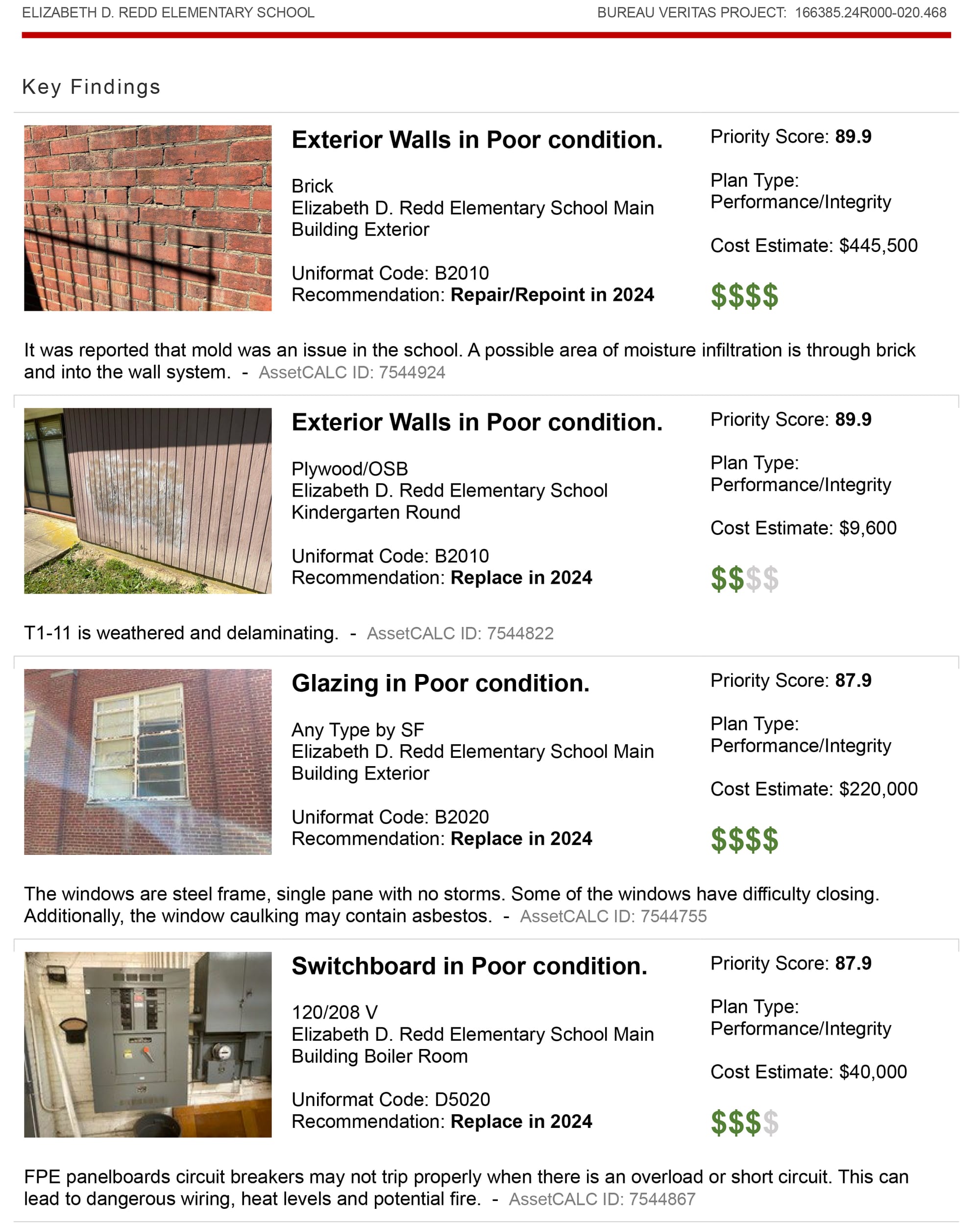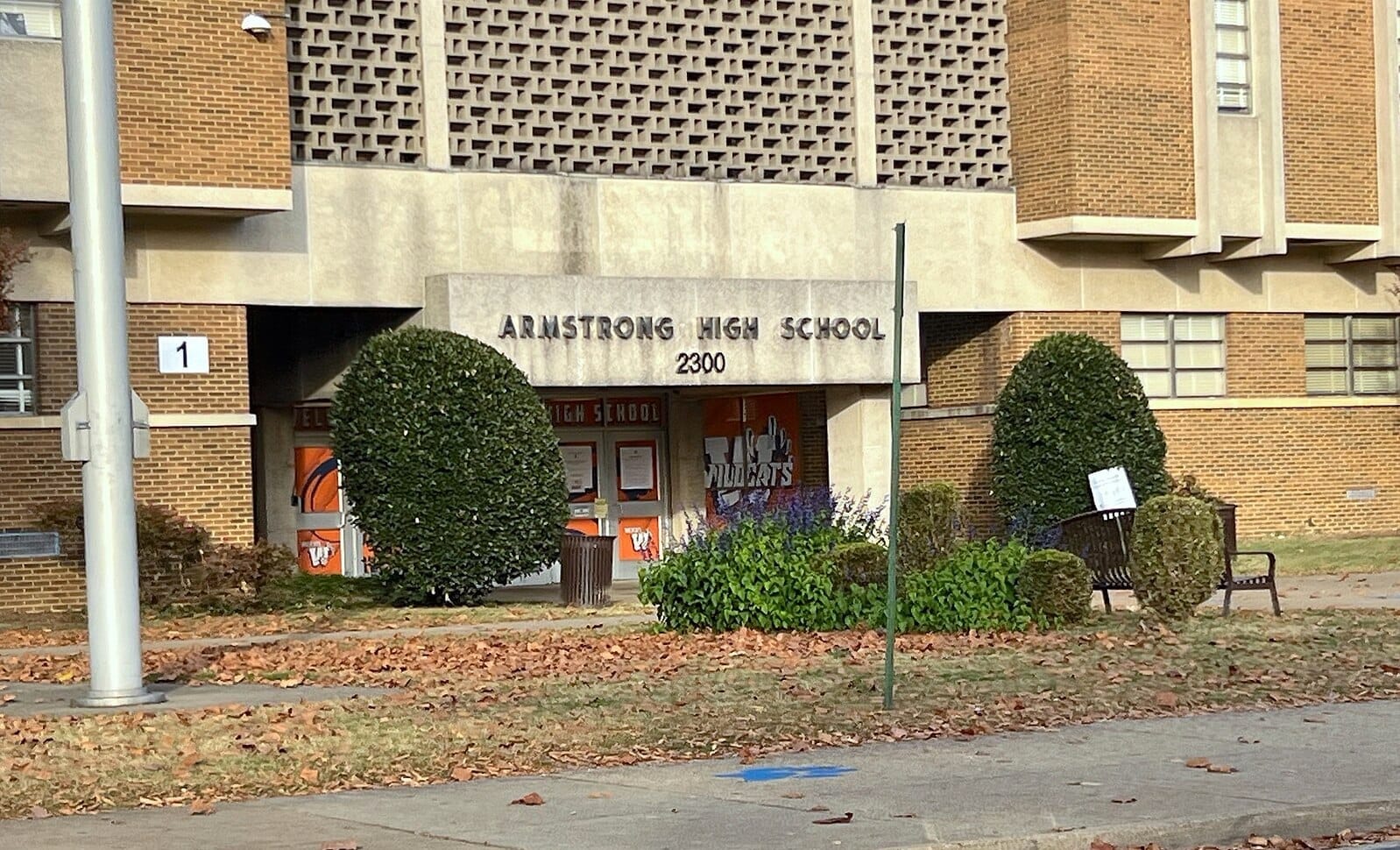
Richmond schools need $43.7 million in immediate repairs, find reports on building conditions
Richmond school buildings need $43.7 million in immediate repairs, according to division calculations based on detailed assessments of the condition of 50 school division facilities that were completed this fall by inspection company Bureau Veritas.
Richmond Public Schools Chief Operating Officer Dana Fox called the total figure “shocking” but said the reports offer a transparent picture of the challenges the school division is facing that will let officials make better decisions about what repairs should happen and when.
“We need to get ourselves in a position of a proactive state versus a reactive one,” she said. “And the only way to do that is to know where things are about to fail.”
Bureau Veritas, a global consulting firm, has conducted similar facilities reviews for school systems around the country, including Boston Public Schools. Richmond Public Schools hired the firm to do its facilities assessments for just over $495,000 in April 2022 after a competitive bidding process.

The Richmond School Board has long complained that the city provides inadequate funding to maintain the division’s schools, which serve approximately 21,000 students and are in varying states of disrepair. But until now the division has lacked a comprehensive overview of the condition at each of the buildings it controls and what it could cost to bring them up to acceptable standards.
The 50 Bureau Veritas reports, which were reviewed by The Richmonder, document over the course of thousands of pages both deficiencies and strengths in school facilities’ structural, electrical, mechanical, fire and plumbing systems, as well as site conditions like parking lots, sidewalks and athletic and play facilities. All of them are the result of site visits, plan and records reviews and interviews with available management personnel.
Some of the findings are surprising. Several of the division’s oldest buildings — like the 1925 Albert Hill Middle in the Museum District, the 1925 Richmond Community High in Northside and the 1924 Richmond Success Academy in Jackson Ward — appear to have no structural problems despite their age.
“Sometimes a lot of folks say, ‘Well, my building is 100 years old. We need a new building,’” said Fox. “Well, structurally speaking, these 80- to 100-year-old buildings are far superior to new construction.”

Most of the findings, however, are sobering. Twenty-four reports indicate pre-existing concerns about mold linked to leaks from piping or ceiling tiles or note that Bureau Veritas inspectors detected it themselves during site visits. Many schools lack fire sprinkler systems because they were built before building codes required them and contain ceiling and floor tiles that are likely made of asbestos. Heating and air conditioning problems turn up again and again, with many schools relying heavily on window units to bring temperatures down in warm weather.
“The hallways also lack any sort of air conditioning, which strains the current system on hot days,” reads the report on Thomas Jefferson High in the Museum District. At George W. Carver Elementary in Carver, temperatures are “difficult to control.” At Open High in Oregon Hill, building managers reported “heating and cooling is difficult to manage and high humidity is a problem in basement and hallways.” The relatively new Broad Rock Elementary in the Southside records temperature variations as high as seven degrees between the building’s three levels.
One likely contributor to the temperature problem: aging and drafty windows. Numerous Richmond schools like the 1912 Swansboro Elementary on the South Side still have their original single-pane windows, whose poor insulating ability can drive up energy costs steeply. Others have rotting window frames or are in disrepair; at Thomas Jefferson High, “most, if not all do not close properly.”
Overall, the reports calculate that $7.1 million is needed for 2024 repairs — of which $5.6 million is required for fixes to external walls — and $36.6 million is needed for 2025. Of that, the biggest chunk, $18.2 million, is needed for roofing.
Roof leaks are another theme of the Bureau Veritas reports. They are catalogued at multiple schools, including the East End’s Woodville Elementary, which was built in 1954 “and has not had any renovations since,” and at the 1968 Armstrong High; at the Northside’s Barack Obama Elementary, which was built in 1921 “and has not undergone any significant renovations since”; and at the Southside’s 1986 Boushall Middle, to name only a few.
For Fox, the reports also spotlight needs that are “often overlooked” and frequently end up on the chopping block during budget season: repairs to cracked sidewalks, resurfacing of parking lots riddled with potholes and faded striping and fixes to athletic courts.
The latter “doesn’t seem like a priority because it’s not within the four walls of the building, and so it kind of just gets glanced over until it’s time to have a state championship or have a big game, and it’s like, these facilities suck,” she said. “Well, we’re trying not to have that narrative be what it is, but really we have to figure out a way to make sure that outside of the four walls is also a priority, even though parking lots sound boring or painting a track sounds lame.”
Not all of the $43.7 million flagged by the reports would be new spending. Alyssa Schwenk, a spokesperson for Richmond Public Schools, said the division’s current capital improvements plan already includes commitments for $2.4 million in HVAC work, $10.6 million in roof projects and $3 million to repair a crumbling exterior wall at John Marshall High.
Fox also said millions of dollars in grant funds spent by Richmond Public Schools on HVAC projects during the pandemic put the division “a little bit ahead of the curve.”
“I think had we not done that, these reports would look way scarier,” she said.
The findings will likely be a key topic of discussion during the upcoming budget season this winter and an early test for Mayor-Elect Danny Avula, who will take office in January. School division funding has long being a top source of tension between City Council, the mayor’s office and the School Board, trailed only by school construction, which the School Board took control of from the city in 2021.
“We’re in a position to not be able to do anything about” the funding needs, said Fox. “We can’t take on debt. We can’t levy taxes. We can’t issue bonds. We are at the mercy of someone else funding this effort.”
In the meantime, Richmond Public Schools plans to craft a master facilities plan based on the findings of the reports that will help officials prioritize repairs and make informed decisions about whether schools should be renovated or replaced. The division also intends to create a capital improvement projects committee that will include both members of Superintendent Jason Kamras’ administration and members of the public.
“What I really wanted with all of this was full transparency — for folks to see we don't have anything to hide here. We're not choosing what we feel is important to repair or do, we're choosing it based on this,” said Fox. “Instead of us saying, ‘Hey, everything’s failing, we don't know what to do, we just need some money for some of these things,’ we really have a roadmap to say, ‘This is what needs to happen in order for us to continue teaching and learning in these buildings.’”






